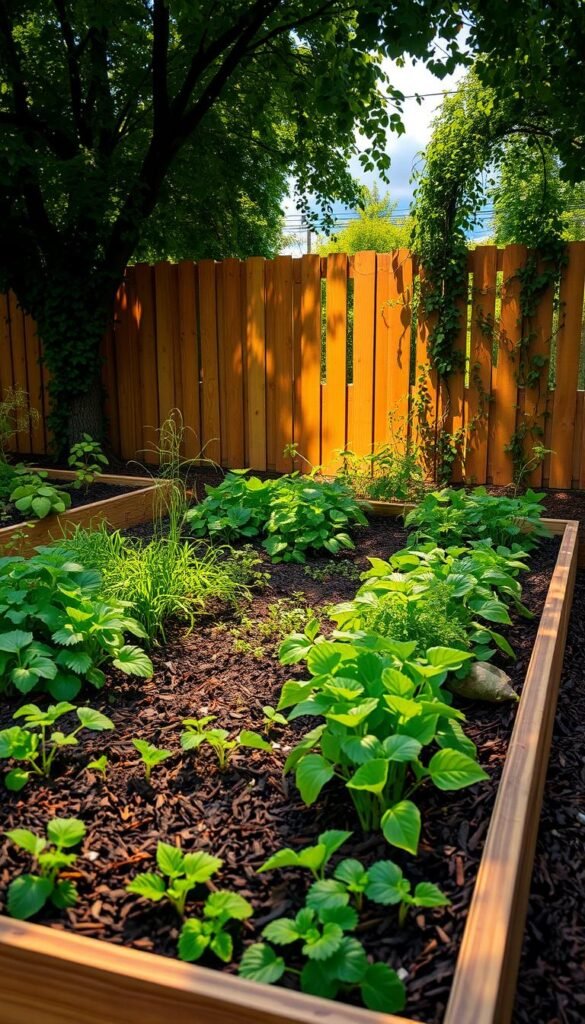Imagine growing lush, thriving plants without ever turning your garden beds. This innovative approach focuses on preserving natural soil ecosystems by avoiding disruptive digging or tilling. Instead of breaking up the earth, you’ll build fertile layers using organic materials like compost and mulch.
By leaving the soil undisturbed, you protect beneficial microbes and worms that keep your garden healthy. Over time, added compost breaks down naturally, creating a nutrient-rich environment for roots. Experts agree this method improves moisture retention and reduces weeds by up to 50% compared to traditional techniques.
Starting is simple: layer materials like straw, leaves, or manure directly on top of existing beds. These additions suppress weeds while feeding the soil as they decompose. Many gardeners report better plant growth within just one season, with even more benefits over years of use.
Whether you’re growing vegetables or flowers, this low-effort strategy works in almost any climate. It saves time during spring planting and requires no special tools—just a commitment to working with nature, not against it.
Understanding the No-Dig Gardening Philosophy
Have you ever considered letting nature do the heavy lifting in your garden? This approach skips disruptive practices like tilling, focusing instead on building fertile layers from the top down. By leaving the earth undisturbed, you preserve its delicate ecosystem of microbes and worms—essential allies for thriving plants.
What Is No-Dig Gardening?
Instead of digging, you layer materials like compost, straw, or leaves directly onto beds. These additions break down naturally, feeding roots while suppressing unwanted growth. Think of it as creating a cozy blanket for your garden that keeps moisture in and weeds out.
Benefits Over Traditional Tilling Methods
Turning soil might seem helpful, but it actually brings buried weed seeds to the surface where they sprout. No-dig keeps them trapped below, cutting weeding time by half in many cases. Experts like Charles Dowding note that undisturbed beds develop richer organic matter over time, leading to healthier plants.
Studies from the Royal Horticultural Society show this method improves water retention and nutrient cycling compared to conventional digging. Plus, you’ll spend less time maintaining beds and more enjoying your harvest. For a deeper dive into how it stacks up against older techniques, explore no-dig vs traditional approaches.
Essentials for Starting a No-Dig Garden Bed
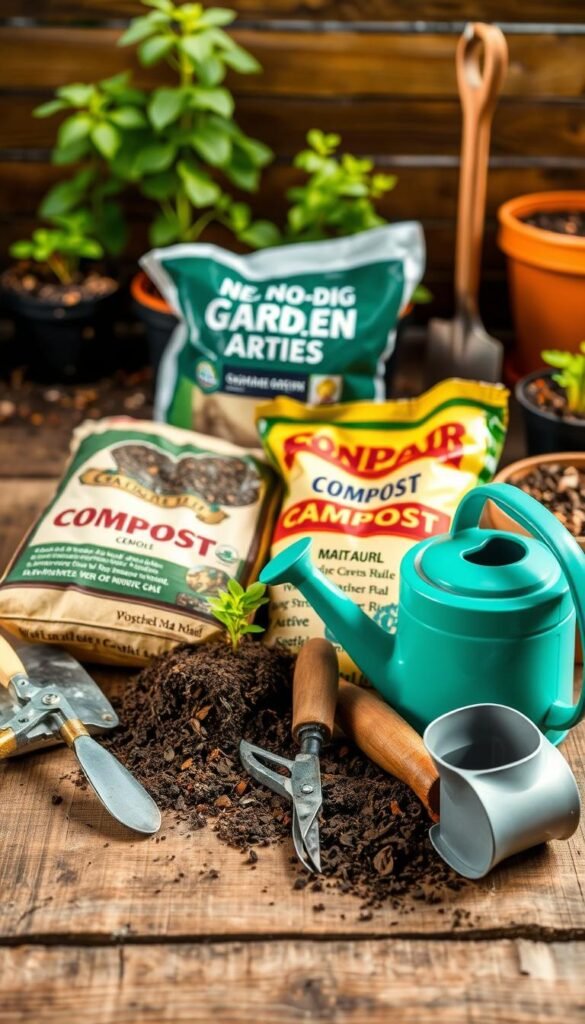
Ready to create a thriving garden bed without the backache? Success begins with smart material choices and thoughtful placement. Let’s explore what you’ll need to set up your space efficiently.
Key Materials and Tools You Need
Your foundation starts with compost – nature’s multivitamin for soil. Layer it with straw for moisture control and recycled cardboard to block weeds. Urban growers often mix in aged manure for an extra nutrient boost, while rural gardeners might use fallen leaves.
You’ll only need basic tools: a pitchfork for moving materials and a watering can. A wheelbarrow helps transport bulky items, but even repurposed buckets work. Remember, quality matters – better inputs mean healthier plants.
Choosing the Ideal Location
Find a sunny spot that gets 6-8 hours of daily light. Ensure the area drains well – soggy soil drowns roots. A 4×8 foot space is perfect for your first year, letting you master the method without overwhelm.
Test your ground by observing after rain. Puddles that linger more than an hour? Add coarse sand to improve drainage. Nearby trees stealing sunlight? Trim lower branches. Your plants will thank you with vigorous growth.
The Science Behind Soil Health and Organic Layers
What if your garden’s success starts with what you don’t do? Leaving the ground undisturbed allows natural processes to thrive. Those rich, dark layers of compost you add aren’t just food for plants—they’re entire ecosystems working underground.
Every time you spread compost on beds, you’re building a living sponge. Organic matter feeds microbes that glue soil particles into stable clumps. This creates air pockets for roots to breathe and water to flow freely. Studies show undisturbed beds hold 40% more moisture than tilled ones during dry spells.
Beneficial fungi form vast networks beneath the surface, acting like nutrient highways for plants. These organisms break down compost gradually, releasing nitrogen and phosphorus exactly when roots need them. It’s nature’s slow-release fertilizer system.
Less digging means carbon stays locked in the ground instead of escaping as CO₂. Over time, this builds richer beds that resist erosion. Researchers found gardens using layered compost see 30% stronger root growth within two years—proof that patience pays off.
Your garden becomes a self-sustaining cycle. Worms till the soil naturally, while decomposed layers suppress weeds. Just keep adding an inch of compost annually, and watch your plants thrive with less work from you.
Preparing Your Garden Without Digging
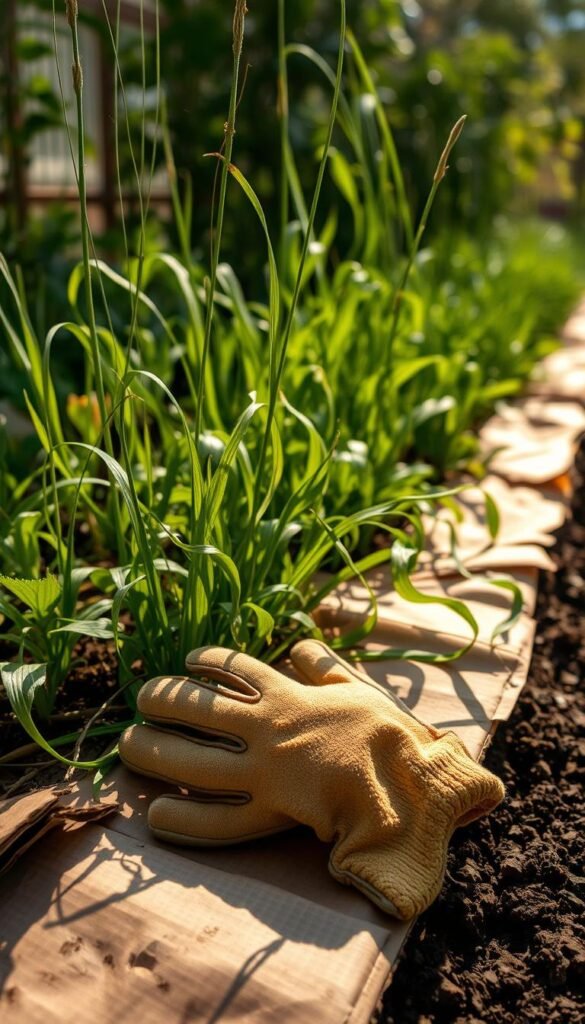
Want to kickstart your garden without breaking a sweat? Layering cardboard and newspaper over existing grass creates an instant weed barrier. This method blocks sunlight while letting earthworms do the tilling for you.
Smothering Weeds with Cardboard and Newspaper
Start by mowing existing vegetation short. Overlap plain cardboard sheets (remove tape) or 8-10 newspaper layers to prevent gaps. Thoroughly soak the material – this speeds decomposition and helps it mold to the ground.
The barrier stops weed seeds from sprouting by cutting off their light source. Over 3-6 months, microbes break down the paper while enriching the soil. By spring, you’ll have a plant-ready bed needing just a bit of compost on top.
| Method | Time Spent | Weed Reduction | Soil Impact |
|---|---|---|---|
| Traditional Digging | 4+ hours | 40% | Disrupts microbes |
| Cardboard Layering | 1 hour | 75% | Boosts organic matter |
In your first year, this setup reduces weeding by half compared to tilled plots. Add 3 inches of compost annually to maintain fertility. You’re not just growing plants – you’re cultivating a living ecosystem.
Layering Techniques for Building Fertile Soil
What’s the secret to soil that feeds itself? Layering organic materials creates a powerhouse of nutrients while keeping weeds at bay. Think of it as building a lasagna—alternating carbon-rich and nitrogen-packed ingredients that decompose into black gold.
Constructing Organic Matter Layers
Start with cardboard or newspaper to smother existing weeds. Add 4 inches of straw for airflow, then 2 inches of compost to kickstart microbial activity. Alternate green materials (grass clippings) and brown layers (fallen leaves) like a lasagna garden. Horticulturists recommend keeping each section under 6 inches thick for optimal breakdown.
Hügelkultur takes it further by burying logs beneath layers. As wood decomposes, it releases moisture and nutrients slowly—perfect for drought-prone areas. This method boosts soil fertility for up to 20 years with minimal upkeep.
Effective Mulching Practices
Top your layers with 3 inches of mulch. Straw works for veggies, while wood chips suit perennials. Mulch blocks light from weed seeds and reduces evaporation by 70%. Renew it annually to maintain protection.
| Method | Cost/Year | Weed Control | Nutrient Release |
|---|---|---|---|
| Layering | $15 | 85% | 2-3 years |
| Digging | $40 | 50% | 6 months |
Your garden becomes a living system. Earthworms transport nutrients between layers, while fungi break down tough materials. This approach saves $25 annually per 100 sq ft compared to tilling—and your back will thank you.
No-Dig Gardening: Perfecting Soil Health with Minimal Effort
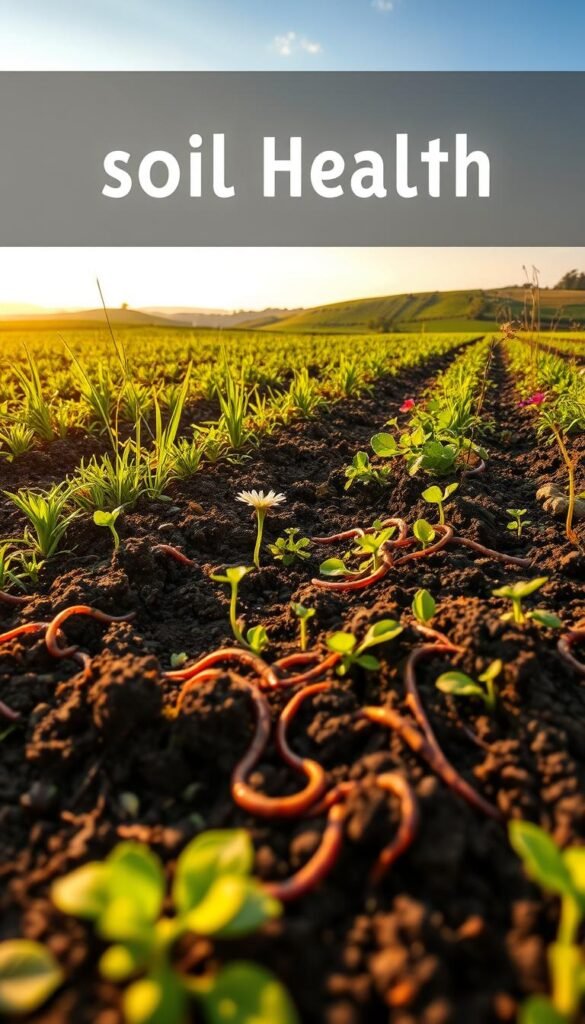
Transforming your outdoor space starts with three simple rules: don’t disturb the ground, feed the earth naturally, and let tiny helpers do the work. This approach creates a self-sustaining cycle where your garden improves yearly with less effort from you.
By skipping tilling, you protect the underground network of fungi and microbes that plants rely on. These organisms break down organic matter into nutrients while improving soil structure. In your first year, you’ll notice fewer weeds and better water absorption as the layers settle.
| Principle | Traditional Approach | This Method | Result |
|---|---|---|---|
| Soil Disturbance | Annual tilling | Zero digging | Healthier microbes |
| Inputs | Synthetic fertilizers | Compost layers | Richer organic matter |
| Weed Control | Herbicides | Cardboard barriers | 75% less weeding |
| Timeframe | Seasonal replanting | Multi-year fertility | Stronger plants |
Gardeners like Margaret from Oregon saw tomato yields double in her third season using these principles. The secret? Letting decomposing compost feed beds slowly while earthworms aerate the soil naturally. Just add 2-3 inches of fresh compost each spring to maintain momentum.
Your role shifts from laborer to observer. Watch how soil life transforms compacted dirt into fluffy, dark earth that sprouts vigorous plants. This method isn’t just easier—it’s a long-term investment in your garden’s future.
Organic Matter and Composting Strategies
Ever wonder what makes compost the superhero of your garden? The right mix of organic materials feeds your soil while creating a thriving underground community. Let’s break down how to choose and maintain these natural powerhouses.
Types of Compost and Organic Additives
Not all compost works the same. Homemade piles offer diverse nutrients but require patience—they take 6-12 months to mature. Aged manure (1-2 years old) delivers quick nitrogen boosts, while store-bought options provide convenience for urban growers.
Enhance your mix with coffee grounds for acidity-loving plants or crushed eggshells for calcium. Leaf mold works wonders for moisture retention, and seaweed adds trace minerals. Always test compost by smell: earthy = good, sour = needs more time.
| Type | Cost | Nutrient Level | Best For |
|---|---|---|---|
| Homemade | $0 | High | All-purpose use |
| Aged Manure | $15/cubic yard | Medium-High | Vegetables |
| Commercial | $30/bag | Medium | Container plants |
When and How to Refresh Your Layers
Add 2-3 inches of fresh compost each spring before planting. In fall, top beds with leaves or straw to protect soil over winter. If plants show slow growth mid-season, sprinkle a half-inch of compost tea as a quick pick-me-up.
Watch your soil’s texture—if it feels dense, mix in coarse sand during refreshes. For sandy earth, add extra leaf mold. These tweaks keep your garden thriving while cutting fertilizer costs by 60% annually.
Managing Weeds Naturally in Your No-Dig Garden
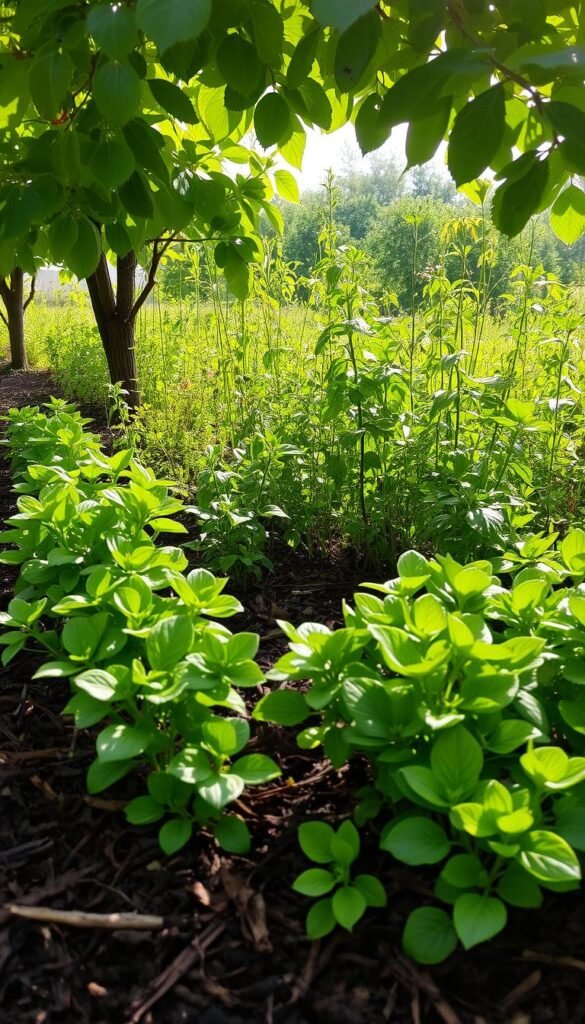
What if weeds could become a rare sight without harsh chemicals? Layering organic materials creates a fortress against unwanted growth. Thick compost blankets block light from reaching weed seeds, stopping them before they sprout. This approach works with nature’s rhythms instead of fighting them.
Suppressing Weed Seeds Without Chemicals
Start by smothering problem areas with cardboard or 10 sheets of newspaper. Wet these layers thoroughly to help them mold to the ground. Top with 4 inches of straw and 2 inches of compost – this duo starves existing weeds while feeding your soil.
Check beds weekly during the growing season. Spot a stray green intruder? Pluck it by hand before it flowers. Regular monitoring cuts weeding time by 80% after the first year. Many gardeners keep a bucket nearby for quick removal.
| Method | Weed Reduction | Labor Required | Timeframe |
|---|---|---|---|
| Chemical Sprays | 90% | Low | 1 season |
| Organic Layering | 75% | Moderate | 2+ years |
| Hand Weeding | 50% | High | Ongoing |
Reducing herbicides lets beneficial insects thrive. Ladybugs and ground beetles move in, naturally controlling pests. A Michigan State study found layered beds host 3x more earthworms than conventional plots – nature’s tillers working for free.
Sarah from Colorado shares: “My weeding time dropped from 8 hours weekly to just 30 minutes after switching methods. The best part? Watching butterflies return to my garden.” Her experience mirrors research showing 60% fewer weeds in no-dig systems within three years.
Water Retention and Drainage Benefits of No-Dig Beds
Have you ever noticed how a sponge holds water yet stays airy? That’s exactly how layered beds work. Undisturbed soil acts like nature’s storage system, soaking up moisture while letting excess drain away. The secret lies in preserving natural channels created by roots and worms over years.
Compacted earth struggles to absorb rain, leading to runoff. But when you add compost and mulch, these materials create a crumbly texture. This structure holds 30% more water than tilled ground while preventing soggy roots. Researchers found such beds need watering 50% less often during dry spells.
| Method | Water Retention | Drainage Quality | Maintenance |
|---|---|---|---|
| No-Dig Beds | High | Excellent | Low |
| Traditional Beds | Medium | Poor | High |
| Container Gardening | Low | Variable | Moderate |
In summer, tomatoes thrive with steady moisture from decomposing layers. Come fall, kale plants access deep reserves during cooler weeks. Even in rainy seasons, excess water filters through instead of pooling.
Your garden becomes drought-resilient without constant attention. A 2-inch compost top-up each spring maintains this balance. You’ll spend less time hauling hoses and more enjoying robust plants that weather nature’s ups and downs.
Optimizing Plant Health and Root Growth
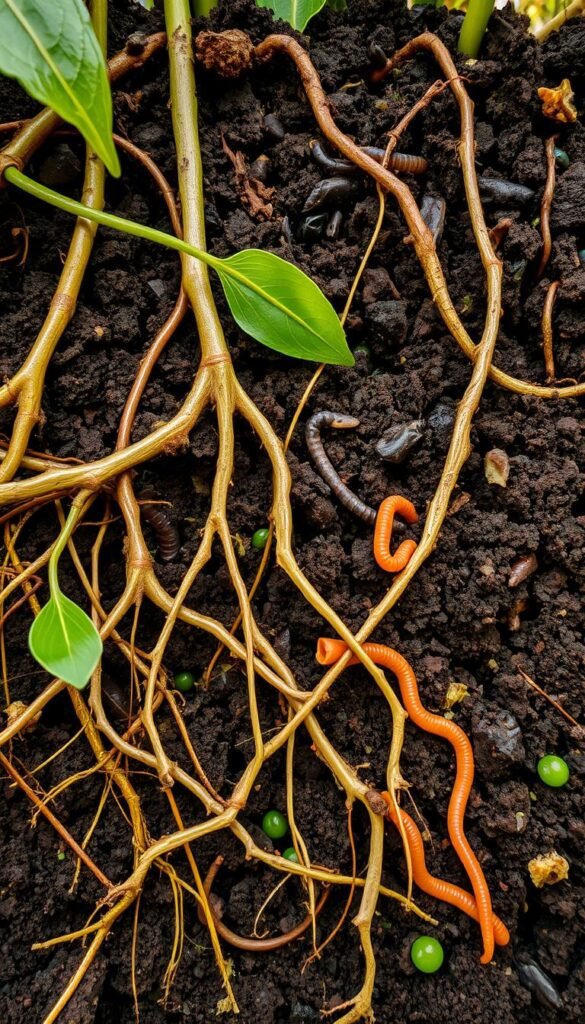
What if your plants could feed themselves better than any fertilizer? When you leave soil undisturbed, roots stretch deeper to access nutrients and moisture. This natural process creates a thriving underground world where microbes and fungi become your garden’s secret workforce.
Encouraging Beneficial Soil Organisms
Earthworms tunnel through beds, creating air pockets that help plant roots breathe. Mycorrhizal fungi form partnerships with roots, acting like nutrient delivery systems. These organisms break down organic matter into plant-ready food while fighting harmful bacteria.
To keep this ecosystem thriving, avoid synthetic chemicals. Instead, add compost tea or worm castings every 6 weeks. Research shows gardens using these methods see 40% faster growth rates compared to conventional plots.
Maximizing Nutrient Uptake for Your Plants
Layer fresh compost around existing plants each spring—about 1 inch thick. This “top dressing” method feeds roots without disrupting their growth. For new planting, make holes just big enough for seedlings to minimize soil disturbance.
Proper spacing matters too. Crowded plants compete for resources, while well-spaced ones develop stronger roots. A study from Cornell University found tomatoes grown this way produced 30% more fruit over three seasons.
Want to understand your soil’s hidden language? Explore these surprising soil secrets to fine-tune your approach. With time, your garden becomes a self-sustaining powerhouse where every layer works in harmony.
Raised Beds and Alternative No-Dig Methods
Elevating your growing space might be the upgrade your plants need. Constructed beds let you control soil quality while working smarter in tricky landscapes. This approach shines where natural ground conditions fall short.
Why Raised Beds Excel
Building upward improves drainage instantly—a lifesaver in clay-heavy areas. The loose structure prevents compaction, letting roots spread freely. Gardeners in rainy regions report 3 extra growing weeks each year as elevated beds warm faster in spring.
Fill frames with alternating layers of compost, straw, and leaf mold. This creates a fluffy base that holds moisture without waterlogging. One Minnesota grower doubled her carrot harvest using this method, noting “roots grew straighter in the loose layers.”
Hügelkultur: Nature’s Sponge
Bury logs under your garden beds to create slow-release fertility. As wood decomposes, it acts like a moisture reservoir during dry spells. Start with large branches at the base, then add smaller twigs and compost on top.
Urban gardener Mark from Seattle shares: “My hugel mound grew pumpkins twice as big as ground-planted ones. It’s been productive for 5 years without added fertilizers.” This technique turns yard waste into long-term soil enrichment.
| Feature | Raised Beds | Hügelkultur |
|---|---|---|
| Materials | Lumber, compost | Logs, branches |
| Setup Time | 1-2 hours | Half day |
| Best For | Poor drainage areas | Drought-prone zones |
| Longevity | 5-7 years | 10+ years |
Both methods reduce bending and weeding while boosting yields. Choose raised beds for quick results or hugelkultur for decade-long fertility. Your back—and plants—will thank you.
Seasonal Considerations for No-Dig Gardening
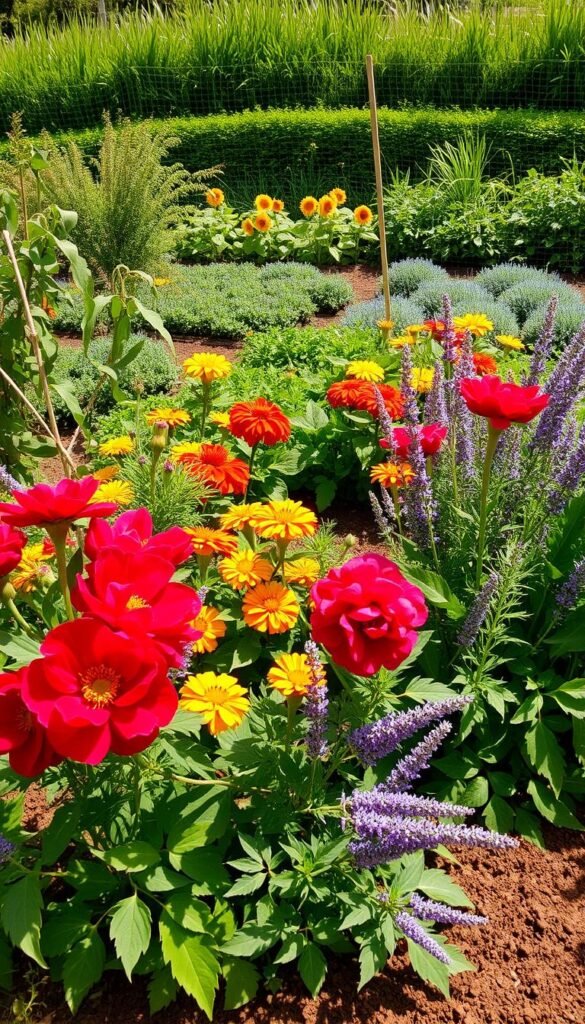
Ever wondered how the changing seasons affect your garden’s underground world? Timing your organic additions keeps soil thriving year-round. Late winter through early spring offers the perfect window to refresh beds before roots start stretching.
Best Times to Start and Layer Your Beds
New beds thrive when created in fall or early spring. Cooler temperatures let materials break down slowly, feeding microbes without overwhelming them. Spread 2 inches of compost in March to prep for planting—earthworms will mix it naturally as soil warms.
Refresh existing beds every 6-8 months. Try this schedule:
- Early spring: Top-dress with half-inch compost
- Late summer: Add straw mulch to retain moisture
- Fall: Layer leaves for winter protection
Adapting Your Approach Across Growing Seasons
Summer heat demands thicker mulch to prevent drying. Use grass clippings or shredded bark—they reflect sunlight while locking in water. In rainy seasons, reduce layers slightly to improve drainage.
Winter prep matters most in cold zones. Cover beds with cardboard weighted by rocks. This shields soil from erosion while suppressing early weeds. Come spring, you’ll find crumbly earth ready for seeds.
| Season | Key Task | Benefit |
|---|---|---|
| Spring | Add compost | Nutrient boost |
| Summer | Mulch heavily | Moisture control |
| Fall | Layer leaves | Winter insulation |
| Winter | Protect beds | Erosion prevention |
Stick to this rhythm, and your garden becomes a self-renewing system. Plants grow stronger each year as layers deepen—proof that working with seasons beats fighting them.
Eco-Friendly and Sustainable Gardening Practices
What if your garden could fight climate change while bursting with life? By working with natural cycles instead of against them, you create spaces that nourish both people and the planet. Organizations like the Royal Horticultural Society confirm this approach slashes environmental impact while boosting biodiversity.
Reducing Your Carbon Footprint Naturally
Every layer of compost you spread acts like a carbon vault. Undisturbed soil stores 30% more CO₂ than tilled earth, according to recent studies. Using local materials like fallen leaves or grass clippings cuts transportation emissions too.
Skip synthetic fertilizers—they require fossil fuels to produce. Instead, let earthworms and microbes recycle nutrients naturally. One gardener in Vermont reduced her household waste by 40% through composting kitchen scraps for her garden.
Supporting Biodiversity in Your Garden
Diverse plants attract pollinators and pest controllers. Native flowers feed bees, while dense foliage shelters frogs and beetles. Even a small herb patch can host over 20 insect species.
Try these simple swaps:
- Replace wood chips with straw mulch (better for ground-nesting bees)
- Plant marigolds among vegetables to deter pests naturally
- Leave some leaf litter for overwintering butterflies
| Practice | Conventional | Sustainable | Impact |
|---|---|---|---|
| Weed Control | Herbicides | Cardboard barriers | Safe for earthworms |
| Fertilizer | Chemical blends | Compost tea | Boosts soil life |
| Water Use | Sprinklers | Rain barrels | Cuts consumption 50% |
Your green space becomes a sanctuary where plants, animals, and soil thrive together. It’s not just about harvests—it’s about creating legacies of abundance.
Overcoming Common Challenges in No-Dig Gardening
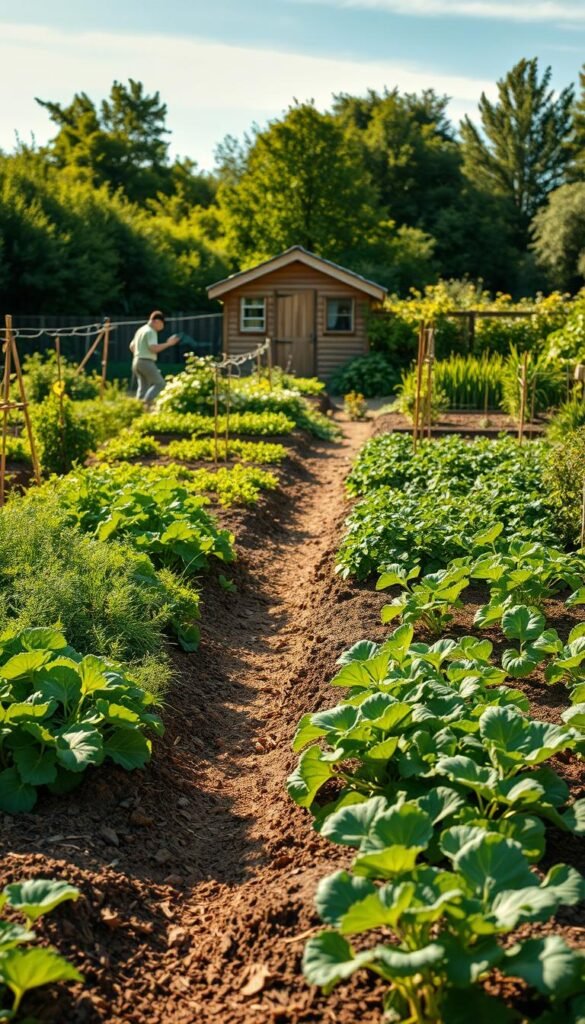
Struggling to keep your garden thriving without constant effort? Even seasoned enthusiasts face hurdles when adopting new methods. Let’s tackle two frequent concerns—material shortages and delayed results—with practical fixes.
Managing Limited Organic Material
Can’t find enough compost? Start small. Use kitchen scraps mixed with fallen leaves for DIY mulch. Many communities offer free wood chips or grass clippings—check local landscaping companies.
Try these budget-friendly swaps:
- Use shredded newspaper as a base layer (avoid glossy prints)
- Plant nitrogen-fixing cover crops like clover between seasons
- Mix coffee grounds from cafes into your compost
Urban gardeners often partner with restaurants for vegetable peels. One New York grower built three raised beds using donated brewery grain.
Patience and Persistence with Slow Initial Results
Your soil won’t transform overnight. It takes 1-2 years for layers to fully integrate. Track progress with simple tests:
| Year | Soil Quality | Weed Reduction |
|---|---|---|
| 1 | Loose texture | 40% |
| 2 | Dark, crumbly | 65% |
| 3+ | Self-fertilizing | 85% |
California grower Maria shares: “My first carrot harvest was puny. By year three, roots grew twice as thick.” Add a bit of fish emulsion if plants lag, but trust the process.
Focus on quick wins like potatoes or zucchini while waiting for perennial crops. Each season, your garden becomes more resilient—proof that time rewards the persistent.
Expert Insights and Proven Techniques
What separates thriving gardens from struggling ones? Often, it’s applying wisdom from those who’ve mastered the craft. Seasoned growers and scientists alike share strategies that turn good results into exceptional harvests.
Advice from Seasoned Gardeners
Charles Dowding, a pioneer in this field, recommends starting small. “Focus on perfecting a 4×4 foot bed first,” he advises. His trials show these starter plots yield 20% more than larger, neglected areas. Many successful growers layer materials in fall so winter frosts break them down naturally.
Key lessons from experienced hands:
- Use compost from multiple sources (yard waste, food scraps) for balanced nutrients
- Refresh beds every 6-8 weeks with thin compost layers
- Pair deep-rooted plants like carrots with shallow herbs to maximize space
Tips from Horticultural Authorities
Guy Barter of the Royal Horticultural Society emphasizes timing. “Add straw mulch in late spring,” he notes. “This prevents summer soil crusting.” Research shows proper layering reduces watering needs by 35% compared to bare earth.
University trials reveal three game-changers:
- Mix coffee grounds into compost to boost nitrogen levels
- Place cardboard under raised beds for long-term weed control
- Rotate crops annually to prevent nutrient depletion
An Oregon gardener using these methods doubled her tomato yield in two years. Her secret? Letting worms aerate beds while she focused on strategic planting. For more success stories, explore how others achieved healthier soil and fewer weeds through simple adjustments.
Embracing a Greener Future Through No-Dig Gardening
Ready to join a movement that grows more than plants? This approach lets you cultivate abundance while healing the earth. By building fertile layers instead of breaking ground, you create spaces where life thrives above and below the surface.
Your efforts yield double rewards: juicy vegetables for your table and richer soil for future seasons. Less weeding means more time to enjoy colorful blooms or watch bees dance among herbs. Each layer of compost becomes a gift to earthworms and microbes working beneath your feet.
This isn’t just a method—it’s a partnership with nature. Over years, undisturbed beds develop deep networks of fungi that feed plants naturally. Birds and butterflies return as chemicals fade from your garden, creating vibrant ecosystems in your backyard.
Start small this spring with a single bed. Layer cardboard, then kitchen scraps and leaves. Watch how quickly life emerges—strong roots, fewer weed battles, and soil that breathes. Your choices today shape tomorrow’s harvests, one sustainable layer at a time.

